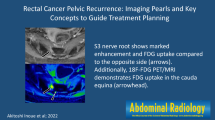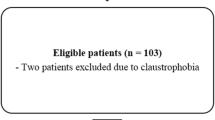Abstract
Purpose
The role of positron emission tomography/magnetic resonance (PET/MR) in evaluating the local extent of rectal cancer remains uncertain. This study aimed to investigate the possible role of PET/MR versus magnetic resonance (MR) in clinically staging rectal cancer.
Methods
This retrospective two-center cohort study of 62 patients with untreated rectal cancer investigated the possible role of baseline staging PET/MR versus stand-alone MR in determination of clinical stage. Two readers reviewed T and N stage, mesorectal fascia involvement, tumor length, distance from the anal verge, sphincter involvement, and extramural vascular invasion (EMVI). Sigmoidoscopy, digital rectal examination, and follow-up imaging, along with surgery when available, served as the reference standard.
Results
PET/MR outperformed MR in evaluating tumor size (42.5 ± 21.03 mm per the reference standard, 54 ± 20.45 mm by stand-alone MR, and 44 ± 20 mm by PET/MR, P = 0.004), and in identifying N status (correct by MR in 36/62 patients [58%] and by PET/MR in 49/62 cases [79%]; P = 0.02) and external sphincter infiltration (correct by MR in 6/10 and by PET/MR in 9/10; P = 0.003). No statistically significant differences were observed in relation to any other features.
Conclusion
PET/MR provides a more precise assessment of the local extent of rectal cancers in evaluating cancer length, N status, and external sphincter involvement. PET/MR offers the opportunity to improve clinical decision-making, especially when evaluating low rectal tumors with possible external sphincter involvement.






Similar content being viewed by others
Data availability
The anonymized deidentified datasets generated during and/or analyzed during the current study are available from the corresponding author on reasonable request.
Abbreviations
- CT:
-
Computed tomography
- EMVI:
-
Extramural vascular invasion
- FDG:
-
2-Deoxy-2-[18F]fluoroglucose
- MR:
-
Magnetic resonance
- N:
-
Lymph node
- PET/CT:
-
Positron emission tomography/computed tomography
- PET/MR:
-
Positron emission tomography/magnetic resonance
- T:
-
tumor
References
Tarver T. Cancer Facts & Figures 2012. American Cancer Society (ACS). J Consumer Health Internet. 2012:366–7. https://doi.org/10.1080/15398285.2012.701177.
Siegel RL, Fedewa SA, Anderson WF, Miller KD, Ma J, Rosenberg PS, et al. Colorectal Cancer Incidence Patterns in the United States, 1974–2013. JNCI: J Natl Cancer Inst. 2017. https://doi.org/10.1093/jnci/djw322.
Siegel RL, Miller KD, Goding Sauer A, Fedewa SA, Butterly LF, Anderson JC, et al. Colorectal cancer statistics, 2020. CA Cancer J Clin. 2020. https://doi.org/10.3322/caac.21601.
Al-Sukhni E, Milot L, Fruitman M, Beyene J, Charles Victor J, Schmocker S, et al. Diagnostic accuracy of mri for assessment of T category, lymph node metastases, and circumferential resection margin involvement in patients with rectal cancer: a systematic review and meta-analysis. Ann Surg Oncol. 2012:2212–23. https://doi.org/10.1245/s10434-011-2210-5.
Kim H, Lim JS, Choi JY, Park J, Chung YE, Kim M-J, et al. Rectal cancer: comparison of accuracy of local-regional staging with two- and three-dimensional preoperative 3-T MR imaging. Radiology. 2010;254:485–92.
Beets-Tan RG, Beets GL, Vliegen RF, Kessels AG, Van Boven H, De Bruine A, et al. Accuracy of magnetic resonance imaging in prediction of tumour-free resection margin in rectal cancer surgery. Lancet. 2001;357:497–504.
Blomqvist L, Machado M, Rubio C, Gabrielsson N, Granqvist S, Goldman S, et al. Rectal tumour staging: MR imaging using pelvic phased-array and endorectal coils vs endoscopic ultrasonography. Eur Radiol. 2000:653–60. https://doi.org/10.1007/s003300050979.
Brown G, Radcliffe AG, Newcombe RG, Dallimore NS, Bourne MW, Williams GT. Preoperative assessment of prognostic factors in rectal cancer using high-resolution magnetic resonance imaging. Br J Surg. 2003:355–64. https://doi.org/10.1002/bjs.4034.
Akasu T, Iinuma G, Fujita T, Muramatsu Y, Tateishi U, Miyakawa K, et al. Thin-section MRI with a phased-array coil for preoperative evaluation of pelvic anatomy and tumor extent in patients with rectal cancer. Am J Roentgenol. 2005:531–8. https://doi.org/10.2214/ajr.184.2.01840531.
Nougaret S, Jhaveri K, Kassam Z, Lall C, Kim DH. Rectal cancer MR staging: pearls and pitfalls at baseline examination. Abdom Radiol (NY). 2019;44:3536–48.
Jhaveri KS, Hosseini-Nik H. MRI of rectal cancer: an overview and update on recent advances. AJR Am J Roentgenol. 2015;205:W42–55.
Sambrook A, Mcateer D, Yule S, Phull P. MR colonography without bowel cleansing or water enema: a pilot study. Br J Radiol. 2012;85:921–4.
Keeling AN, Morrin MM, McKenzie C, Farrell RJ, Sheth SG, Ngo L, et al. Intravenous, contrast-enhanced MR colonography using air as endoluminal contrast agent: Impact on colorectal polyp detection. Eur J Radiol. 2012:31–8. https://doi.org/10.1016/j.ejrad.2010.10.028.
Zijta FM, Bipat S, Stoker J. Magnetic resonance (MR) colonography in the detection of colorectal lesions: a systematic review of prospective studies. Eur Radiol. 2010;20:1031–46.
Graser A, Melzer A, Lindner E, Nagel D, Herrmann K, Stieber P, et al. Magnetic resonance colonography for the detection of colorectal neoplasia in asymptomatic adults. Gastroenterology. 2013;144:743–50.e2.
Saegesser F, Sandblom P. Ischemic lesions of the distended colon: a complication of obstructive colorectal cancer. Am J Surg. 1975;129:309–15.
Ogawa S, Hida J-I, Ike H, Kinugasa T, Ota M, Shinto E, et al. Selection of lymph node-positive cases based on perirectal and lateral pelvic lymph nodes using magnetic resonance imaging: study of the japanese society for cancer of the colon and rectum. Ann Surg Oncol. 2016;23:1187–94.
Gröne J, Loch FN, Taupitz M, Schmidt C, Kreis ME. Accuracy of Various Lymph Node Staging Criteria in Rectal Cancer with Magnetic Resonance Imaging. J Gastrointest Surg. 2018;22:146–53. https://doi.org/10.1007/s11605-017-3568-x.
Bipat S, Glas AS, Slors FJM, Zwinderman AH, Bossuyt PMM, Stoker J. Rectal cancer: local staging and assessment of lymph node involvement with endoluminal US, CT, and MR imaging—a meta-analysis. Radiology. 2004:773–83. https://doi.org/10.1148/radiol.2323031368.
Kotanagi H, Fukuoka T, Shibata Y, Yoshioka T, Aizawa O, Saito Y, et al. The size of regional lymph nodes does not correlate with the presence or absence of metastasis in lymph nodes in rectal cancer. J Surg Oncol. 1993;(4):252. https://doi.org/10.1002/jso.2930540414.
Dworák O. Number and size of lymph nodes and node metastases in rectal carcinomas. Surg Endosc. 1989:96–9. https://doi.org/10.1007/bf00590909.
Fang SH, Efron JE, Berho ME, Wexner SD. Dilemma of stage II colon cancer and decision making for adjuvant chemotherapy. J Am Coll Surg. 2014;219:1056–69.
Dienstmann R, Salazar R, Tabernero J. Personalizing colon cancer adjuvant therapy: selecting optimal treatments for individual patients. J Clin Oncol. 2015;33:1787–96.
Cserni G. The influence of nodal size on the staging of colorectal carcinomas. J Clin Pathol. 2002;55:386–90.
Kim DJ, Kim JH, Ryu YH, Jeon TJ, Yu J-S, Chung J-J. Nodal staging of rectal cancer: high-resolution pelvic MRI versus 18F-FDGPET/CT. J Comput Assist Tomogr. 2011;35:531–4.
Eglinton T, Luck A, Bartholomeusz D, Varghese R, Lawrence M. Positron-emission tomography/computed tomography (PET/CT) in the initial staging of primary rectal cancer. Color Dis. 2009:667–73. https://doi.org/10.1111/j.1463-1318.2009.01873.x.
Hotta M, Minamimoto R, Yano H, Gohda Y, Shuno Y. Diagnostic performance of F-FDG PET/CT using point spread function reconstruction on initial staging of rectal cancer: a comparison study with conventional PET/CT and pelvic MRI. Cancer Imaging. 2018;18:4.
Heusner TA, Hahn S, Hamami ME, Kim U-H, Baumeister R, Forsting M, et al. Gastrointestinal 18F-FDG accumulation on PET without a corresponding CT abnormality is not an early indicator of cancer development. Eur Radiol. 2009;(9):2171. https://doi.org/10.1007/s00330-009-1405-7.
Amorim BJ, Hong TS, Blaszkowsky LS, Ferrone CR, Berger DL, Bordeianou LG, et al. Clinical impact of PET/MR in treated colorectal cancer patients. Eur J Nucl Med Mol Imaging. 2019;46:2260–9.
Ferrone C, Goyal L, Qadan M, Gervais D, Sahani DV, Zhu AX, et al. Management implications of fluorodeoxyglucose positron emission tomography/magnetic resonance in untreated intrahepatic cholangiocarcinoma. Eur J Nucl Med Mol Imaging. 2019. https://doi.org/10.1007/s00259-019-04558-3.
Catalano OA, Rosen BR, Sahani DV, Hahn PF, Guimaraes AR, Vangel MG, et al. Clinical impact of PET/MR imaging in patients with cancer undergoing same-day PET/CT: initial experience in 134 patients--a hypothesis-generating exploratory study. Radiology. 2013;269:857–69.
Martin O, Schaarschmidt BM, Kirchner J, Suntharalingam S, Grueneisen J, Demircioglu A, et al. PET/MRI versus PET/CT in whole-body staging: results from a unicenter observational study in 1003 subsequent examinations. J Nucl Med. 2019. https://doi.org/10.2967/jnumed.119.233940.
Mayerhoefer ME, Prosch H, Beer L, Tamandl D, Beyer T, Hoeller C, et al. PET/MRI versus PET/CT in oncology: a prospective single-center study of 330 examinations focusing on implications for patient management and cost considerations. Eur J Nucl Med Mol Imaging. 2020;47:51–60.
Beets-Tan RGH, Lambregts DMJ, Maas M, Bipat S, Barbaro B, Curvo-Semedo L, et al. Magnetic resonance imaging for clinical management of rectal cancer: Updated recommendations from the 2016 European Society of Gastrointestinal and Abdominal Radiology (ESGAR) consensus meeting. Eur Radiol. 2018;28:1465–75.
Wahl RL, Jacene H, Kasamon Y, Lodge MA. From RECIST to PERCIST: Evolving considerations for PET response criteria in solid tumors. J Nucl Med. 2009;50(Suppl 1):122S–50S.
Website [Internet]. [cited 2020 May 31]. Available from: R Core Team (2018). R: A language and environment for statistical computing. R Foundation for Statistical Computing, Vienna, Austria. https://www.R-project.org/
Brown G, Richards CJ, Bourne MW, Newcombe RG, Radcliffe AG, Dallimore NS, et al. Morphologic predictors of lymph node status in rectal cancer with use of high-spatial-resolution MR imaging with histopathologic comparison. Radiology. 2003;227:371–7.
Taylor SA, Bomanji JB, Manpanzure L, Robinson C, Groves AM, Dickson J, et al. Nonlaxative PET/CT colonography: feasibility, acceptability, and pilot performance in patients at higher risk of colonic neoplasia. J Nucl Med. 2010;51:854–61.
Funding
This study received no specific funding.
Author information
Authors and Affiliations
Contributions
All authors contributed to the study conception and design. Material preparation, data collection, and analysis, and first draft were performed primarily by Onofrio Antonio Catalano. All authors commented on previous versions of the manuscript, as well as read and approved the final manuscript.
Corresponding author
Ethics declarations
Conflict of interest
The authors declare that they have no conflict of interest.
Ethical approval
This study was reviewed by the Institutional Review Board and carried out in accordance with the ethical standards of the institutional and/or national research committee and with the 1964 Helsinki Declaration and its later amendments or comparable ethical standards.
Consent to participate/consent for publication
Informed consent was waived due to the retrospective nature of the study.
Code availability
Not applicable.
Additional information
Publisher’s note
Springer Nature remains neutral with regard to jurisdictional claims in published maps and institutional affiliations.
Summary statement
PET/MR is a promising modality in staging rectal cancer in the pelvis, especially in assessing cancer length, lymphadenopathy and external sphincter involvement.
Key results
PET/MR enabled more accurate evaluation of tumor size, N status, and external sphincter infiltration.
Although PET/MR ensured a better assessment of the T stage than MR, the differences were not statistically significant.
This article is part of the Topical Collection on Oncology - Digestive tract
Electronic supplementary material
ESM 1
(DOCX 19 kb)
Rights and permissions
About this article
Cite this article
Catalano, O.A., Lee, S.I., Parente, C. et al. Improving staging of rectal cancer in the pelvis: the role of PET/MRI. Eur J Nucl Med Mol Imaging 48, 1235–1245 (2021). https://doi.org/10.1007/s00259-020-05036-x
Received:
Accepted:
Published:
Issue Date:
DOI: https://doi.org/10.1007/s00259-020-05036-x




